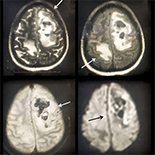SARS-CoV-2-Associated Acute Hemorrhagic, Necrotizing Encephalitis (AHNE) Presenting with Cognitive Impairment in a 44-Year-Old Woman without Comorbidities: A Case Report
Challenging differential diagnosis, Unusual setting of medical care, Rare disease
Ritwik Ghosh, Souvik Dubey, Josef Finsterer, Subham Chatterjee, Biman Kanti Ray
Am J Case Rep 2020; 21:e925641
DOI: 10.12659/AJCR.925641
Available online: 2020-08-07
Published: 2020-08-16
 BACKGROUND:
Acute hemorrhagic necrotizing encephalitis (AHNE) is a rare manifestation of severe acute respiratory syndrome coronavirus-2 (SARS-CoV-2) infection. AHNE usually involves the subcortical white matter but not the cortical grey matter. This study describes the disruptive effects of AHNE associated with SARS-CoV-2 on cognitive function in a previously healthy and sound middle-aged woman resulting from alterations in cortical areas involved in the cognitive network.
BACKGROUND:
Acute hemorrhagic necrotizing encephalitis (AHNE) is a rare manifestation of severe acute respiratory syndrome coronavirus-2 (SARS-CoV-2) infection. AHNE usually involves the subcortical white matter but not the cortical grey matter. This study describes the disruptive effects of AHNE associated with SARS-CoV-2 on cognitive function in a previously healthy and sound middle-aged woman resulting from alterations in cortical areas involved in the cognitive network.CASE REPORT: A 44-year-old previously healthy woman with a history of inter-state travel developed a flu-like illness, followed by acute, steadily progressive cognitive impairment. She was admitted in a comatose state after a first tonic-clonic seizure. Blood tests were non-informative. Cerebral magnetic resonance imaging (MRI) was indicative of AHNE. Cerebrospinal fluid analysis showed mild lymphocytosis with normal protein and normal glucose but an elevated IgG index. After testing positive for SARS-CoV-2, she was administered steroids. Treatment was ineffective, and the patient died.
CONCLUSIONS: SARS-CoV-2 is a potential central nervous system (CNS) pathogen, which may manifest as AHNE. These patients may present with generalized tonic-clonic seizures and frontal dysexecutive syndrome, with cognitive impairment being the presenting feature of neuro-coronavirus disease-2019 (COVID-19). The patient described in this report is unique for acute-onset and isolated cognitive impairments due to SARS-CoV-2 infection in the absence of clinical or radiological respiratory manifestations. These findings may help in the early detection and diagnosis of neuro-COVID-19, especially among clinicians and neurologists working in areas of endemic SARS-CoV-2 infection.
Keywords: COVID-19, Leukoencephalitis, Acute Hemorrhagic, SARS Virus, Betacoronavirus, COVID-19, Cerebral Hemorrhage, cognitive dysfunction, Coronavirus Infections, Encephalitis, Fatal Outcome, Immunoglobulin G, Magnetic Resonance Imaging, Pandemics, Pneumonia, Viral, SARS-CoV-2, Seizures

